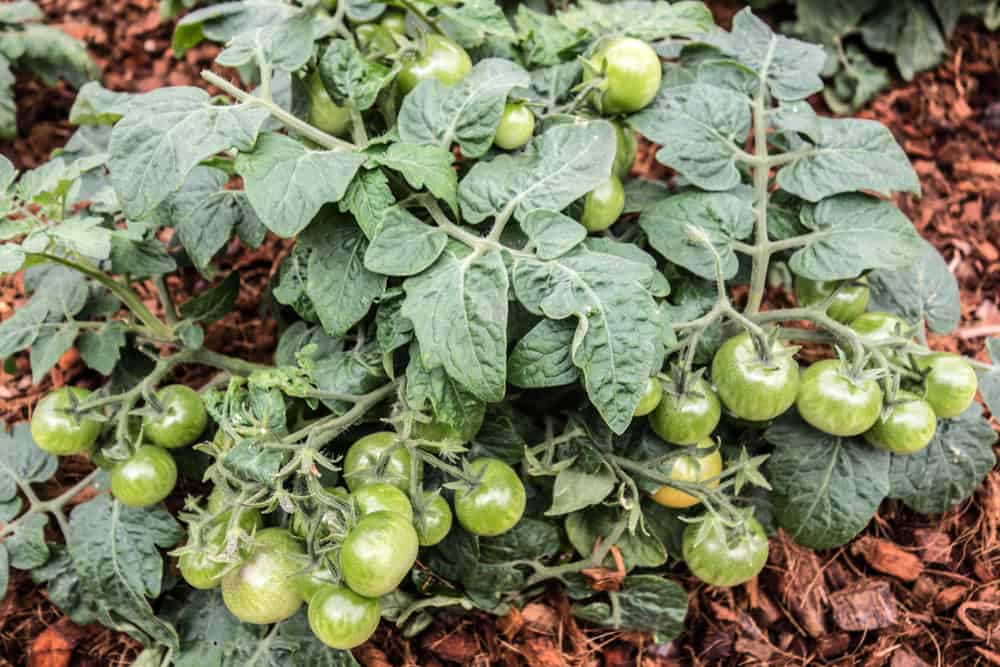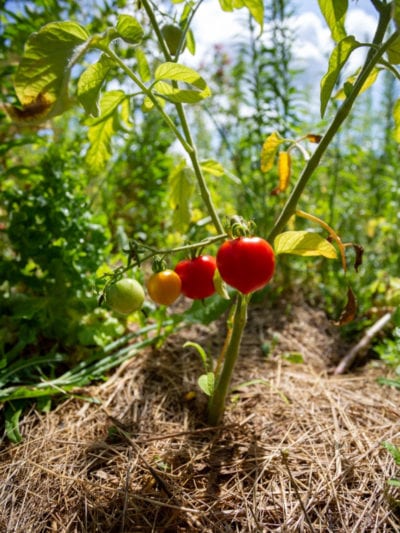To mulch tomatoes, apply a layer of organic mulch around the base of the plants. This helps retain moisture, suppress weeds, and regulate soil temperature, promoting healthier growth and higher yields.
Mulching tomatoes is an essential practice for gardeners seeking to optimize their tomato plants’ health and productivity. By carefully applying a layer of organic mulch, gardeners can create an optimal growing environment for their tomato plants. This simple technique offers various benefits, such as moisture retention, weed suppression, and temperature regulation.
In turn, these advantages contribute to healthier plants with higher yields. Whether you are a seasoned gardener or just starting out, mulching tomatoes is a straightforward process that can make a significant difference in your overall tomato-growing experience. We will explore the steps and considerations involved in effectively mulching tomatoes to help you achieve the best possible results in your garden.

Credit: www.tomatobible.com
Benefits Of Mulching Tomatoes
Mulching tomatoes offers numerous benefits. One of its advantages is that it conserves moisture, which is crucial for maintaining healthy plants. By placing a layer of mulch onto the soil surface, it reduces water evaporation, allowing the plants to retain moisture better.
Additionally, mulching effectively controls weeds, as it acts as a barrier, preventing weed growth and competition for nutrients. This eliminates the need for frequent weeding, saving time and effort. Moreover, mulching helps regulate soil temperature, preventing extreme fluctuations. It keeps the soil cool during hot summer days and insulates it during colder nights, creating an optimal growing environment for tomatoes.
Overall, the practice of mulching tomatoes is a simple yet effective technique to enhance their growth and productivity.
How to Mulch Tomatoes: Step by Step Guide
Organic Mulch Options
Organic mulch options for tomatoes include straw, hay, grass clippings, leaves, and compost. These mulching materials offer numerous benefits for tomato plants. Straw provides excellent insulation and moisture retention. Hay can act as a protective barrier against weeds. Grass clippings add fertility to the soil while keeping it cool.
Leaves create a natural mulch that decomposes gradually, providing nutrients. Compost enriches the soil, enhances water absorption, and supports beneficial microorganisms. Applying organic mulch around tomato plants helps regulate soil temperature, conserve moisture, suppress weeds, and prevent soil erosion. It also improves soil structure, aeration, and nutrient availability, resulting in healthier and more productive tomatoes.
When mulching tomatoes, remember to apply a layer of mulch about 2-3 inches deep, keeping it a few inches away from the plant stems. Regularly check moisture levels and adjust watering accordingly to maintain optimal tomato growth.
Inorganic Mulch Options
Tomatoes can benefit from inorganic mulch options like plastic mulch and landscape fabric. Plastic mulch creates a barrier between the soil and the tomato plants, reducing weed growth and conserving moisture. Landscape fabric, on the other hand, is a permeable material that allows water and nutrients to reach the plants while keeping weeds at bay.
These mulch options help maintain soil temperature and prevent soil-borne diseases from splashing onto the plants. Plastic mulch is especially effective in warming the soil, promoting early growth and higher yields. Meanwhile, landscape fabric offers easy installation and removal, making it a convenient option for regular crop rotation.
When choosing inorganic mulch for tomatoes, consider factors such as the climate, soil type, and specific requirements of your plants for optimal growth and productivity. Remember to secure the mulch properly to prevent it from being blown away by strong winds.
Preparation
To mulch tomatoes effectively, proper preparation is essential. Start by clearing the area around the plants, removing any weeds or debris. This ensures a clean and healthy environment for the tomatoes to thrive. Next, prepare the soil by loosening it with a garden fork or tiller, allowing for better water and nutrient absorption.
Water the plants thoroughly before adding the mulch, as moist soil enhances the benefits of mulching. Mulching helps retain moisture, suppress weeds, regulate soil temperature, and prevent diseases. Apply a layer of organic mulch, such as straw, shredded leaves, or compost, around the tomato plants, ensuring it is about 2-3 inches thick.
Avoid covering the plant’s base to prevent stem rot. With proper mulching and regular maintenance, your tomato plants will enjoy improved growth and productivity.
Applying The Mulch
Mulching tomatoes is an important step in their care. When applying the mulch, it is crucial to spread it evenly. Make sure to maintain a consistent thickness throughout the entire tomato bed. Additionally, remember to keep the mulch away from the stems of the plants.
This helps prevent moisture retention and potential rotting. By following these guidelines, you can enhance the growth and health of your tomato plants. Proper mulching helps to control weeds and retain moisture in the soil, while also providing insulation during extreme temperatures.

Take the time to mulch your tomatoes correctly, and you will reap the benefits of a bountiful harvest. So, get started today and give your tomato plants the care they deserve.
Mulch Maintenance
Mulching tomatoes requires regular inspection and adjustment. It is important to check the mulch regularly and add more when needed. By maintaining an adequate layer of mulch, you can help retain moisture and control soil temperature. Additionally, it is crucial to remove any weeds that may appear in the mulch.
Weeds can compete with tomatoes for nutrients and water, so it’s essential to keep the mulch weed-free. Regularly inspecting and adjusting the mulch will help ensure that your tomatoes have the optimal growing conditions. With proper mulch maintenance, you can promote healthy tomato plants and increase your chances of a successful harvest.
Keep an eye on your mulch and make adjustments as necessary to support the growth of your tomatoes.
Frequently Asked Questions For How To Mulch Tomatoes
How Often Should You Mulch Tomatoes?
Mulch tomatoes every 2-4 weeks to maintain soil moisture and control weeds.
What Is The Best Mulch For Tomatoes?
Organic mulches like straw, hay, grass clippings, and wood chips are excellent choices for mulching tomatoes.
How Thick Should Mulch Be On Tomatoes?
Apply a 2-4 inch layer of mulch around tomato plants, keeping it a few inches away from the stem to prevent rot.
Can I Use Cardboard As Mulch For Tomatoes?
Yes, cardboard can be used as a mulch for tomatoes. It helps suppress weeds, retains moisture, and decomposes over time, adding organic matter to the soil.
When Should I Remove Mulch From Tomatoes?
In cooler climates, remove mulch once the danger of frost has passed. In warmer climates, mulch can be kept throughout the growing season to maintain soil moisture.
Can I Use Black Plastic As Mulch For Tomatoes?
Yes, black plastic can be used as a mulch for tomatoes. It helps warm the soil, control weeds, and conserve moisture. Make sure to secure it properly and create holes for plants.
Conclusion
Mulching tomatoes is a crucial step in promoting healthy growth and protecting them from various challenges. By understanding the benefits of mulching, such as conserving soil moisture, preventing weed growth, and regulating soil temperature, gardeners can ensure their tomato plants thrive.
Organic mulch options like straw, grass clippings, or compost can provide additional nutrients as they break down over time. It is important to apply the mulch carefully, keeping it a few inches away from the base of the plants to avoid any rotting or pest issues.
Regularly monitoring the moisture levels and adjusting the mulch thickness accordingly will help maintain optimal growing conditions. Overall, incorporating mulching techniques into your tomato gardening routine can lead to higher yields, healthier plants, and a more enjoyable harvest season.

